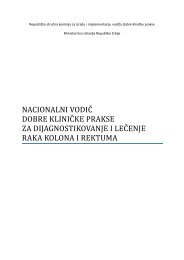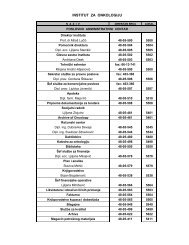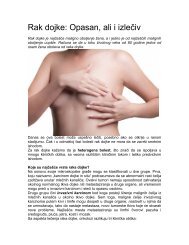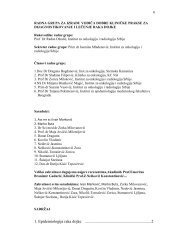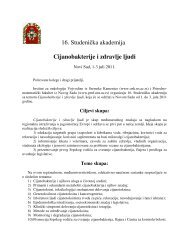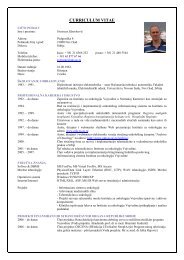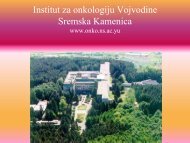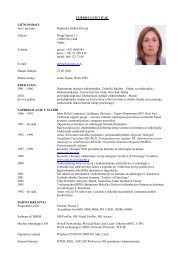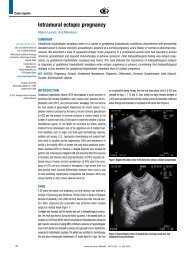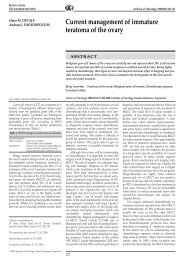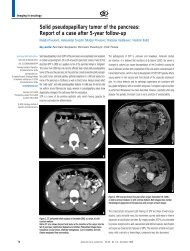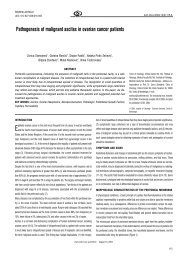Uranium content in the soil of the Federal Republic of Yugoslavia ...
Uranium content in the soil of the Federal Republic of Yugoslavia ...
Uranium content in the soil of the Federal Republic of Yugoslavia ...
You also want an ePaper? Increase the reach of your titles
YUMPU automatically turns print PDFs into web optimized ePapers that Google loves.
Miljeviæ R.N.<br />
were made with standard addition <strong>of</strong> uranyl nitrate. Standard solutions<br />
were prepared and used to obta<strong>in</strong> <strong>the</strong> calibration curve.<br />
Standard reference materials were used to validate <strong>the</strong> analytical<br />
procedure. Decomposition and analysis were duplicated for each<br />
sample. The range <strong>of</strong> <strong>the</strong> relative standard deviation was 3-7%.<br />
RESULTS AND DISCUSSION<br />
The primary objective <strong>of</strong> this survey was to locate <strong>the</strong> deployed<br />
DU. As <strong>the</strong>re were practically no data on <strong>the</strong> levels <strong>of</strong> uranium <strong>in</strong><br />
<strong>the</strong> environment around <strong>the</strong> analyzed locations, undisturbed <strong>soil</strong><br />
samples were taken to obta<strong>in</strong> natural background measurements.<br />
A prelim<strong>in</strong>ary judgement <strong>of</strong> <strong>the</strong> most likely amount <strong>of</strong> uranium<br />
deposited on <strong>the</strong> ground could be made assum<strong>in</strong>g that dur<strong>in</strong>g one<br />
A-10 aircraft engagement 50-100 rounds are fired and that one <strong>of</strong><br />
every five bullets conta<strong>in</strong>s DU (20). Usually, three attack planes<br />
work toge<strong>the</strong>r aga<strong>in</strong>st a target and <strong>the</strong> amount <strong>of</strong> DU <strong>in</strong> <strong>the</strong> area<br />
hit (20x50=1000 m 2 ) might be 9-18 kg. If 10 kg <strong>of</strong> DU were<br />
spread, tak<strong>in</strong>g <strong>in</strong>to consideration <strong>soil</strong> depth <strong>of</strong> 5mm and specific<br />
gravity <strong>of</strong> 1.5 g/cm 3 , <strong>the</strong> uranium concentration <strong>of</strong> <strong>the</strong> <strong>soil</strong> would<br />
be estimated to be about 1300 mg/kg. A similar evaluation could<br />
be made for <strong>the</strong> cruise missile that conta<strong>in</strong>s DU. The dom<strong>in</strong>ant<br />
mechanism for uranium redistribution is <strong>the</strong> surface water pathway<br />
and due to <strong>the</strong> high ra<strong>in</strong>fall, which had occurred <strong>in</strong> June 1999<br />
(up to 30-40 l/m 2 per day) (21), <strong>the</strong> result<strong>in</strong>g concentration,<br />
might be low, much less than assumed. Although <strong>the</strong> estimation<br />
is very rough and would apply only for <strong>the</strong> immediate vic<strong>in</strong>ity <strong>of</strong><br />
<strong>the</strong> target, it is suggested that <strong>the</strong> excess uranium <strong>in</strong> <strong>the</strong> surface<br />
<strong>soil</strong>s would have a ra<strong>the</strong>r low enrichment. Therefore, <strong>the</strong> choice<br />
<strong>of</strong> <strong>the</strong> correct analytic method it is very important for quantitative<br />
analysis <strong>of</strong> DU concentration.<br />
The results <strong>of</strong> our field <strong>in</strong>vestigation are summarized <strong>in</strong> Table 2,<br />
along with <strong>the</strong> description <strong>of</strong> <strong>the</strong> <strong>soil</strong>'s orig<strong>in</strong>. The <strong>in</strong>dividual isotopic<br />
uranium activity ( 238 U) as well as <strong>the</strong> 235 U/ 238 U isotopic<br />
ratio are given. The concentrations <strong>in</strong> <strong>the</strong> surface <strong>soil</strong> (0-5 cm <strong>in</strong><br />
depth) range from 1.7 to 14 mg 238 U/kg dry <strong>soil</strong> and up to 22<br />
Table 2. <strong>Uranium</strong> <strong>content</strong> and its isotopic ratio <strong>in</strong> <strong>the</strong> <strong>in</strong>vestigated <strong>soil</strong>s<br />
mg/kg <strong>of</strong> total uranium. The obta<strong>in</strong>ed isotope ratio from 0.0071 to<br />
0.0075 corresponds to natural uranium abundance (0.00725) at<br />
most locations. In contrast, high values, between 0.0161 and<br />
0.0085, were recorded for <strong>soil</strong> samples taken from bomb craters<br />
<strong>in</strong> Jadovnik, Ra¹ka, and Sjenica. It is worth mention<strong>in</strong>g that a relatively<br />
high ratio <strong>of</strong> 0.0105 was found <strong>in</strong> undisturbed <strong>soil</strong> on<br />
Jadovnik where we expected a control value. These markedly<br />
higher ratios could be expla<strong>in</strong>ed ra<strong>the</strong>r by high count<strong>in</strong>g errors<br />
(45-85%) than by any excess <strong>of</strong> non-natural uranium. On <strong>the</strong><br />
o<strong>the</strong>r hand, <strong>the</strong> errors <strong>of</strong> measur<strong>in</strong>g <strong>the</strong> 238 U <strong>content</strong> for samples<br />
conta<strong>in</strong>g high activity from <strong>the</strong> Cape Arza location were small<br />
(about 7%). The obta<strong>in</strong>ed isotope ratios <strong>of</strong> 0.0011 <strong>in</strong> those samples<br />
<strong>in</strong>dicate that a DU weapon was used at this site.<br />
For comparison, Table 3. lists <strong>the</strong> total uranium concentration<br />
obta<strong>in</strong>ed by g-spectrometry (measured 238 U concentration data,<br />
comb<strong>in</strong>ed with <strong>the</strong> 235 U/ 238 U ratio assum<strong>in</strong>g that 234 U and 236 U<br />
have negligible concentration), and <strong>the</strong> results obta<strong>in</strong>ed with <strong>the</strong><br />
ICP method. Good agreement between data obta<strong>in</strong>ed from undisturbed<br />
locations at Kad<strong>in</strong>jaèa and Jadovnik is evident. The reason<br />
for <strong>the</strong> significant difference between two correspond<strong>in</strong>g samples<br />
taken at o<strong>the</strong>r locations is probably due to <strong>in</strong>terference from Si,<br />
Ca, Fe, and Al (22).<br />
Table 3. Results <strong>of</strong> total uranium concentration by g-spectrometry and <strong>in</strong>ductively<br />
coupled plasma<br />
To confirm <strong>the</strong>se results a more advanced method with higher<br />
analytical precision, such as <strong>the</strong>rmal ionization mass spectrometry<br />
us<strong>in</strong>g isotope dilution spike, should be applied (23). It is reasonable<br />
to suppose that <strong>the</strong> isotopic analysis can uniquely dist<strong>in</strong>guish<br />
contam<strong>in</strong>ation by uranium from <strong>in</strong>digenous uranium present<br />
at background level.<br />
CONCLUSION<br />
The presence <strong>of</strong> DU is difficult to detect directly <strong>in</strong> <strong>the</strong> environment<br />
unless <strong>the</strong> concentration is significantly above background.<br />
The wide range <strong>of</strong> uranium <strong>content</strong> <strong>in</strong> <strong>the</strong> <strong>soil</strong>s (2-22 mg/kg) at<br />
<strong>the</strong> studied locations is due to <strong>the</strong> different type <strong>of</strong> <strong>soil</strong>, <strong>soil</strong> formation<br />
and <strong>soil</strong> transport process (geological orig<strong>in</strong>). The<br />
obta<strong>in</strong>ed values are comparable with those for undisturbed <strong>soil</strong>s,<br />
<strong>in</strong>dicat<strong>in</strong>g that <strong>the</strong>re was no presence <strong>of</strong> DU at <strong>the</strong>se sites with<strong>in</strong><br />
measurement error limits. Only once could deployment <strong>of</strong> a DU<br />
weapon be stated, at <strong>the</strong> studied Cape Arza location where <strong>the</strong><br />
238 U <strong>content</strong> was between 23 and 61 kg/kg.<br />
© 2001, Institute <strong>of</strong> Oncology Sremska Kamenica,<strong>Yugoslavia</strong><br />
248




